Selection of a circulation pump: device, types and rules for choosing a heating pump
Gravity heating systems function fully only in one-story private houses with an area of up to 100 square meters. m.If you need to heat an apartment building or a spacious mansion, then you cannot do without a forced circulation system. The best solution is to select a circulation pump and install the unit in the heating circuit.
We suggest you understand what tasks the pump performs in the heating system, how the device is designed and works. We described the operating features of different types of pumps and outlined the main criteria for making the right choice. The information provided will help you choose the right circulation pump model and not be disappointed with the purchase.
The content of the article:
Why is a pump needed in a heating system?
Circulation pumps are hydraulic equipment that ensures forced movement of heated coolant along a closed circuit. Such devices contribute to uniform and rapid heating of the entire system.
Circulation pumps are installed:
- in order to increase the energy efficiency of boiler equipment;
- in cases where it is not possible to ensure natural circulation of a liquid substance;
- in the absence of a built-in pumping unit in the heat generator;
- for heating systems with a two-pipe circuit, allowing you to adjust the parameters of each individual radiator;
- to overcome the inertia of autonomous systems with natural circulation of fluid used to transfer thermal energy.
The coolant must move along the closed loop of the heating system pipeline at a certain speed to ensure heat transfer to the radiators.
At natural circulation This condition is not always feasible - as a result, the heating equipment does not heat up or heats up unevenly.
Therefore, circulation pumps are installed in heat supply systems. Such devices ensure transportation of coolant through the network at high speed, minimizing the load on the boiler. When returning to the heating element, the water remains warm, which means less energy is required for heating.
Pump design and operating principle
The design of the circulation pump resembles a drainage installation. The pump consists of a robust housing made of stainless steel/cast iron/aluminum and an electrical part that includes a stator winding with an integrated ceramic/steel rotor.
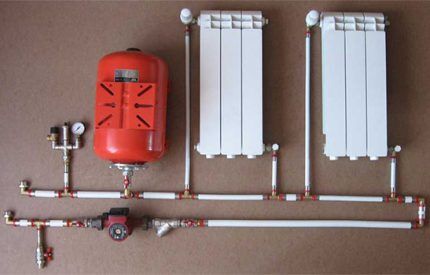
An impeller is fixedly fixed on the shaft of the rotating part of the electric motor.
The impeller consists of two parallel disks connected by radially curved blades. On one of them there is a hole for the flow of coolant fluid, on the other there is a small hole for fixing the impeller on the shaft of the electric motor.
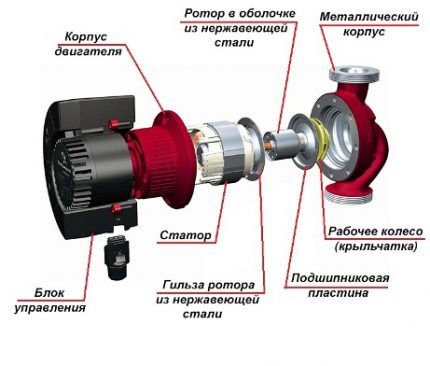
The electric motor itself is equipped with a special control board and terminals for connecting wires.Circulation pumps without electronics have a capacitor installed instead of a board, and a speed switch is located on the terminal box.
When electricity is supplied, the wheel with blades rotates, creating a vacuum in the pipe and pumping coolant. The rotor creates the movement of the working fluid in the direction from the inlet to the outlet valve.
The pump constantly takes water from one side and pushes it into the heating system on the other. Centrifugal force promotes the transport of liquid throughout the pipeline.
The created pressure overcomes resistance in different parts of the circuit and ensures circulation of the coolant.
Judging by the intensity of sales, the most popular in the domestic market are devices from the following manufacturers:
Types and advantages of circulation pumps
Based on their design features, forced circulation pumps are divided into pumping units with a wet rotor and high-performance devices with a dry rotor.
Wet pumps. The rotor and impeller of such pumps are in direct contact with the working fluid, which simultaneously performs two important functions: the role of lubrication and cooling of the device. The rotor and stator in such pumps are separated by a special vessel, which is responsible for the tightness of the elements of the electric motor under voltage.
Wet-type circulation pumps are equipped with a step speed regulator. This allows you to select the optimal operating mode, and therefore control energy consumption.
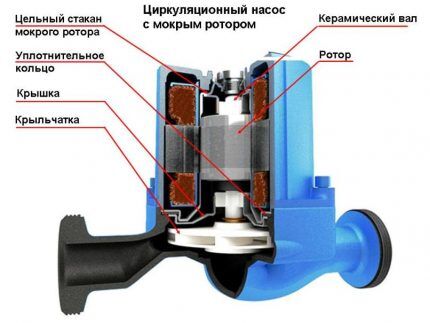
Wet rotor units have a modular design. Individual modules are selected depending on the required pressure and performance. The prefabricated design greatly simplifies pump repair, since a failed module can be easily and quickly replaced with a new one.
Circulation pumps of this type are used in small heating systems. They operate almost silently, and therefore are ideal for installation in residential areas.
The electric motor of wet rotor pumps does not require additional cooling, since it is constantly in contact with water. There are a small number of working parts inside the pump, which minimizes the need for frequent maintenance.
The main advantages of using wet type pumps:
- low noise level;
- small overall dimensions and low weight;
- minimal electricity consumption;
- easy parameter settings, maintenance and repair;
- long service life.
Units with a wet rotor also have disadvantages. They are very sensitive to the quality of the working fluid. The presence of fine abrasive particles in water leads to accelerated wear of the hydraulic part of the pump.
In addition, the efficiency of such circulation pumps does not exceed 55%. However, this indicator is quite sufficient for short pipelines, and therefore pumps that are in direct contact with water are often used in individual heat supply systems.
For trouble-free operation of “wet” type units, it is necessary that pump installation was done correctly. The main requirement is a strictly horizontal spatial orientation of the shaft. Only with this configuration is complete lubrication of the bearings with liquid ensured.
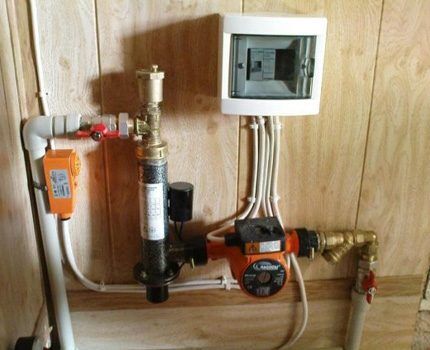
Dry rotor pumps successfully used for pumping large volumes of coolant in large installations.The rotor assembly of such devices does not come into contact with water.
The body part of “dry” type circulation pumps is made of durable cast iron or galvanized steel. The surface is coated with special protective compounds to prevent corrosion.
Units with a dry rotor are suitable for collective use in residential multi-storey buildings, entertainment centers and offices, and industrial facilities.
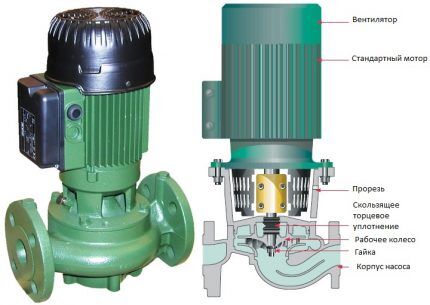
Between the electric motor and the pump part of the pump there is a special sliding seal (2 protective rings), which isolates the basic functional elements from liquid ingress.
These rings are highly polished and are in close contact with each other. One of them (dynamic) is mounted on a rotating shaft. The static wheel is firmly fixed in the pump body.
A thin film of water reliably seals the connection of the protective rings due to differences in pressure in the circuit and the external environment.
For the manufacture of sealing rings, carbon obtained by oil agglomeration is used. Some modifications of pumps intended for use in extreme conditions have metal/ceramic protective rings installed.
The efficiency of dry rotor devices reaches 85%. This is an excellent indicator in comparison with “wet” type pumps. However, “dry” units produce a lot of noise due to the cooling fan, and therefore they are installed in separate rooms with good sound insulation.
There are 3 types of “dry” type circulation pumps:
- monoblock;
- console;
- "In-line".
Monoblock pumps belong to the category of low-pressure units. The electric motor and pump in such devices are mounted in one unit. They are easy to operate and maintain. Suitable for use in public buildings and apartment buildings.
Cantilever pumping devices assembled on a single base, with the axes of the pump and motor being on the same line. The suction pipe is located on the outer part of the volute, the discharge pipe is located on the opposite side of the body.
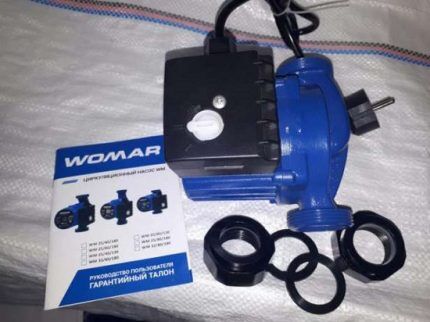
In-line pumps mounted directly on the pipeline. The suction inlet and pressure outlet pipes are located on the same line, and an automatic mechanism is provided to compensate for the wear of the sealing rings.
Advantages of using circulation pumps with a dry rotor:
- high performance;
- energy efficiency;
- low requirements for the quality of the energy carrier - the pumped liquid may contain neutral impurities;
- simple repairs and replacement of spare parts.
In addition, today heating equipment manufacturers offer potential buyers dual pump models. Such devices are used to reserve power and provide additional safety net in emergency situations.
Twin pump motors can operate together or separately. If one pump breaks down, the second device continues to operate normally, ensuring uninterrupted operation of the boiler.
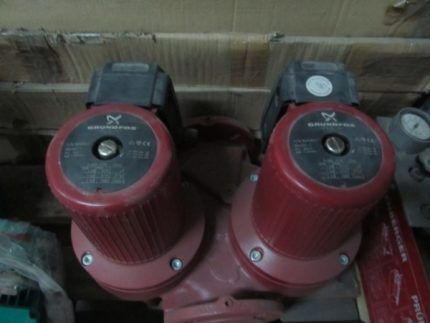
With proper operation, the service life of the circulation pump is at least 10 years.
How to choose the right pumping equipment?
The efficiency of the pump depends on the basic parameters - productivity and pressure. Performance shows the amount of coolant that the unit must pump per unit time. This parameter is determined from the conditions of maximum load.
Pressure is a quantity that expresses the energy of the flow of liquid used as a heat carrier. Takes into account the hydraulic resistance of the entire system.
You should also pay attention to the maximum temperature. Since the pump will pump heated water, it must withstand temperatures up to 110°C.
It is very important to select the appropriate power of the circulation pump. A low-power device will not cope with pumping coolant fluid in the required volume. Pump parameters are selected based on calculations performed.
If you install a more powerful unit, unpleasant noise will appear in the pipeline. Also in this case, the functional elements of the boiler equipment will wear out much faster than stated by the manufacturer.
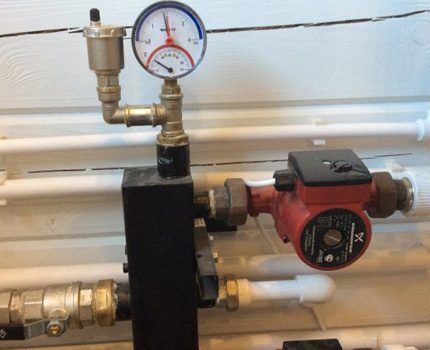
Experts recommend choosing a circulation pump at the design stage of the heating system. If the pipeline length does not exceed 80 m, it is sufficient to install one pump. For larger lengths, it is advisable to install several pumping devices at once.
When purchasing, you should also pay attention to the materials from which the functional elements of the pump are made. Most parts come into direct/indirect contact with the heated working fluid and are therefore subject to rapid wear.
Therefore, it is advisable to give preference to circulation pumps with ceramic bearings and a rotor assembly.
Electronics play an important role.To regulate indoor temperatures in heating circuits, install thermostatic valves. As the temperature rises, they overlap, and the pressure in the pipes increases.
As a result of these processes, unpleasant noise appears. To get rid of it, you need to switch the circulation pump to lower speeds, and doing this manually is inconvenient.
Pumps with built-in electronics will help you cope with this task quickly and efficiently. Such units smoothly regulate pressure drops in the pipeline depending on changes in the amount of liquid.
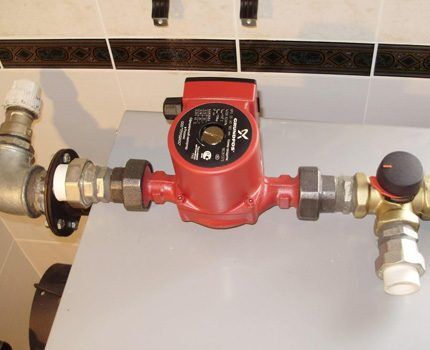
It is worth noting the additional functionality of the pumps, namely:
- smooth adjustment;
- speed control;
- automatic operating mode;
- built-in information display.
The simplest circulation pump models – without the ability to regulate the speed of liquid transportation. Modern multifunctional pumps are two/three-speed units with continuous adjustment. They are distinguished by high precision settings.
Equipment operating in automatic mode is equipped with a control panel. The settings of such devices are extensive and depend only on the modification of the devices.
This can be automatic speed adjustment depending on changes in indoor air temperature, an electronic off/on timer, automatic pump start at minimum flow rate.
The presence of a digital display makes it possible to obtain all the necessary information about the operation of the pumping device: coolant fluid temperature, closed-loop resistance, performance, errors, etc.
Conclusions and useful video on the topic
Rules for choosing circulation equipment in the video:
Subtleties of calculating pressure and productivity in the video clip:
Video about the design, principle of operation and installation of the circulation pump:
A modern heat supply system with a built-in pump for forced circulation allows you to heat living quarters within minutes after starting the heat generator.
Rational selection of a circulation pump and high-quality installation significantly increase the efficiency of using boiler equipment by saving energy resources by approximately 30-35%.
Are you looking for a circulation pump for your heating system? Or do you have experience in operating such installations? Please share your experiences with readers, ask questions and participate in discussions. The comment form is located below.




For a private house or cottage with an area of up to 200 sq.m. take Grundfos, you won’t regret it, of course, it’s actually Danish, but it’s produced in both China and Russia, there’s no difference. The only thing is, don’t take the power suddenly, you need at least a little more, but more.
Place it on the bypass circuit, immediately after the boiler outlet, so that in the event of a pump breakdown, boiler shutdown, electricity or gas outage, you can turn the valve and the coolant will flow straight through the system. This will save your pipes from defrosting or the formation of air locks, and in case of freezing, from pipe rupture.
Install a special generator for it, and preferably a battery, since during power surges or when the lights go out, the pump turns off and can only be started manually. In this case, the boiler itself may turn off.
But if there is a generator, then in terms of reliability this pump has no price.